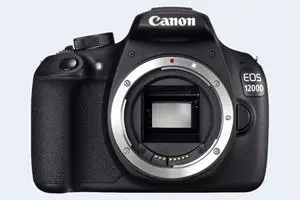Sony RX100 III vs Canon 1200D
The Sony Cyber-shot DSC-RX100 III and the Canon EOS 1200D (labelled Canon T5 in some countries) are two digital cameras that were officially introduced, respectively, in May 2014 and February 2014. The RX100 III is a fixed lens compact, while the 1200D is a DSLR. The cameras are based on an one-inch (RX100 III) and an APS-C (1200D) sensor. The Sony has a resolution of 20 megapixels, whereas the Canon provides 17.9 MP.
Below is an overview of the main specs of the two cameras as a starting point for the comparison.

Check RX100 III offers at
ebay.com

Check 1200D offers at
ebay.com
Going beyond this snapshot of core features and characteristics, what are the differences between the Sony Cyber-shot DSC-RX100 III and the Canon EOS 1200D? Which one should you buy? Read on to find out how these two cameras compare with respect to their body size, their imaging sensors, their shooting features, their input-output connections, and their reception by expert reviewers.
Body comparison
An illustration of the physical size and weight of the Sony RX100 III and the Canon 1200D is provided in the side-by-side display below. The two cameras are presented according to their relative size. Three successive views from the front, the top, and the rear are shown. All width, height and depth dimensions are rounded to the nearest millimeter.
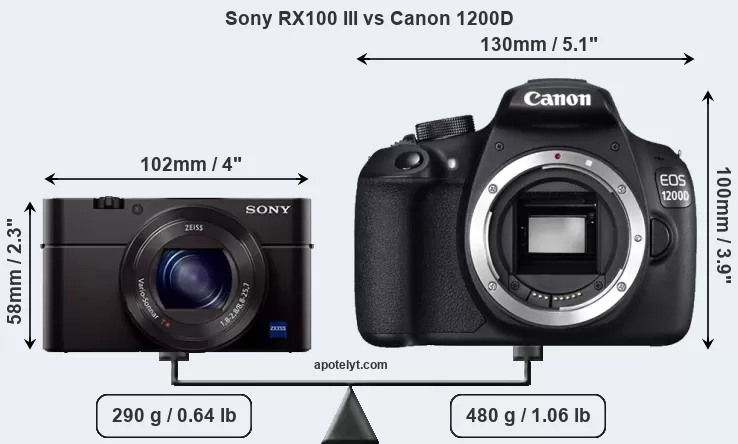
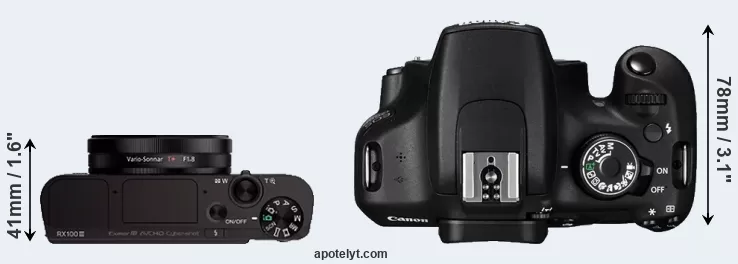
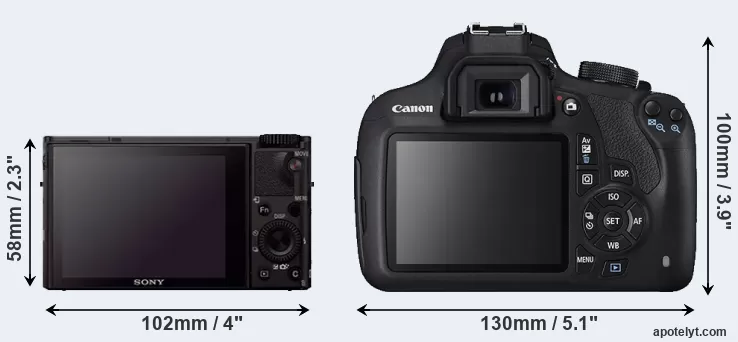
If the front view area (width x height) of the cameras is taken as an aggregate measure of their size, the Canon 1200D is considerably larger (120 percent) than the Sony RX100 III. In this context, it is worth noting that neither the RX100 III nor the 1200D are weather-sealed.
The above size and weight comparisons are to some extent incomplete and possibly misleading, as the RX100 III has a lens built in, whereas the 1200D is an interchangeable lens camera that requires a separate lens. Attaching the latter will add extra weight and bulk to the setup. You can compare the optics available for the 1200D and their specifications in the Canon EF Lens Catalog.
Concerning battery life, the RX100 III gets 320 shots out of its Sony NP-BX1 battery, while the 1200D can take 500 images on a single charge of its Canon LP-E10 power pack. The power pack in the RX100 III can be charged via the USB port, so that it is not always necessary to take the battery charger along when travelling.
The table below summarizes the key physical specs of the two cameras alongside a broader set of comparators. If you want to switch the focus of the display and review another camera pair, you can move across to the CAM-parator tool and choose from the broad selection of possible camera comparisons there.

| Camera Model |
Camera Width |
Camera Height |
Camera Depth |
Camera Weight |
Battery Life |
Weather Sealing |
Camera Launch |
Launch Price (USD) |
Street Price |
||
|---|---|---|---|---|---|---|---|---|---|---|---|
| 1. | Sony RX100 III | 102 mm | 58 mm | 41 mm | 290 g | 320 | n | May 2014 | 799 | ebay.com | |
| 2. | Canon 1200D | 130 mm | 100 mm | 78 mm | 480 g | 500 | n | Feb 2014 | 449 | ebay.com | |
| 3. | Canon 100D | 117 mm | 91 mm | 69 mm | 407 g | 380 | n | Mar 2013 | 549 | ebay.com | |
| 4. | Canon 700D | 133 mm | 100 mm | 79 mm | 580 g | 440 | n | Mar 2013 | 649 | ebay.com | |
| 5. | Canon 1100D | 130 mm | 100 mm | 78 mm | 495 g | 700 | n | Feb 2011 | 449 | ebay.com | |
| 6. | Canon 1300D | 129 mm | 101 mm | 78 mm | 485 g | 500 | n | Mar 2016 | 449 | ebay.com | |
| 7. | Canon 4000D | 129 mm | 102 mm | 77 mm | 436 g | 500 | n | Feb 2018 | 399 | amazon.com | |
| 8. | Canon G5 X | 112 mm | 76 mm | 44 mm | 353 g | 210 | n | Oct 2015 | 799 | ebay.com | |
| 9. | Canon G7 X | 103 mm | 60 mm | 40 mm | 304 g | 210 | n | Sep 2014 | 699 | ebay.com | |
| 10. | Panasonic FZ1000 | 137 mm | 99 mm | 131 mm | 831 g | 360 | n | Jun 2014 | 899 | ebay.com | |
| 11. | Sony RX100 | 102 mm | 58 mm | 36 mm | 240 g | 330 | n | Jun 2012 | 649 | ebay.com | |
| 12. | Sony RX100 II | 102 mm | 58 mm | 38 mm | 281 g | 350 | n | Jun 2013 | 749 | ebay.com | |
| 13. | Sony RX100 IV | 102 mm | 58 mm | 41 mm | 298 g | 280 | n | Jun 2015 | 999 | ebay.com | |
| 14. | Sony RX100 V | 102 mm | 58 mm | 41 mm | 299 g | 220 | n | Oct 2016 | 999 | ebay.com | |
| 15. | Sony RX100 VII | 102 mm | 58 mm | 43 mm | 302 g | 260 | n | Jul 2019 | 1,199 | amazon.com | |
| 16. | Sony ZV-1 | 105 mm | 60 mm | 44 mm | 294 g | 260 | n | May 2020 | 799 | ebay.com | |
| 17. | Sony ZV-1 II | 106 mm | 60 mm | 47 mm | 292 g | 290 | n | May 2023 | 899 | amazon.com | |
| Note: Measurements and pricing do not include easily detachable parts, such as add-on or interchangeable lenses or optional viewfinders. | |||||||||||
Any camera decision will obviously take relative prices into account. The manufacturer’s suggested retail prices give an idea on the placement of the camera in the maker’s lineup and the broader market. Normally, street prices remain initially close to the MSRP, but after a couple of months, the first discounts appear. Later in the product cycle and, in particular, when the replacement model is about to appear, further discounting and stock clearance sales often push the camera price considerably down.
Sensor comparison
The size of the sensor inside a digital camera is one of the key determinants of image quality. All other things equal, a large sensor will have larger individual pixel-units that offer better low-light sensitivity, wider dynamic range, and richer color-depth than smaller pixels in a sensor of the same technological generation. Furthermore, a large sensor camera will give the photographer more possibilities to use shallow depth-of-field in order to isolate a subject from the background. On the downside, larger sensors tend to be associated with larger, more expensive camera bodies and lenses.
Of the two cameras under consideration, the Sony RX100 III features an one-inch sensor and the Canon 1200D an APS-C sensor. The sensor area in the 1200D is 186 percent bigger. As a result of these sensor size differences, the cameras have a format factor of, respectively, 2.7 and 1.6. Both cameras have a native aspect ratio (sensor width to sensor height) of 3:2.
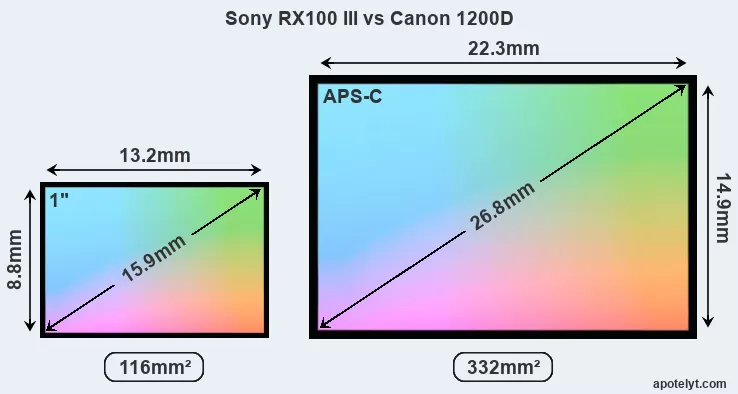
Despite having a smaller sensor, the Sony RX100 III offers a higher resolution of 20 megapixels, compared with 17.9 MP of the Canon 1200D. This megapixels advantage comes at the cost of a higher pixel density and a smaller size of the individual pixel (with a pixel pitch of 2.41μm versus 4.31μm for the 1200D). However, it should be noted that the RX100 III is a somewhat more recent model (by 3 months) than the 1200D, and its sensor might have benefitted from technological advances during this time that partly offset its pixel-size disadvantage.
The resolution advantage of the Sony RX100 III implies greater flexibility for cropping images or the possibility to print larger pictures. The maximum print size of the RX100 III for good quality output (200 dots per inch) amounts to 27.4 x 18.2 inches or 69.5 x 46.3 cm, for very good quality (250 dpi) 21.9 x 14.6 inches or 55.6 x 37.1 cm, and for excellent quality (300 dpi) 18.2 x 12.2 inches or 46.3 x 30.9 cm. The corresponding values for the Canon 1200D are 25.9 x 17.3 inches or 65.8 x 43.9 cm for good quality, 20.7 x 13.8 inches or 52.7 x 35.1 cm for very good quality, and 17.3 x 11.5 inches or 43.9 x 29.3 cm for excellent quality prints.
The Sony Cyber-shot DSC-RX100 III has a native sensitivity range from ISO 100 to ISO 12800, which can be extended to ISO 80-25600. The corresponding ISO settings for the Canon EOS 1200D are ISO 100 to ISO 6400, with the possibility to increase the ISO range to 100-12800.
In terms of underlying technology, the RX100 III is build around a BSI-CMOS sensor, while the 1200D uses a CMOS imager. Both cameras use a Bayer filter for capturing RGB colors on a square grid of photosensors. This arrangement is found in most digital cameras.
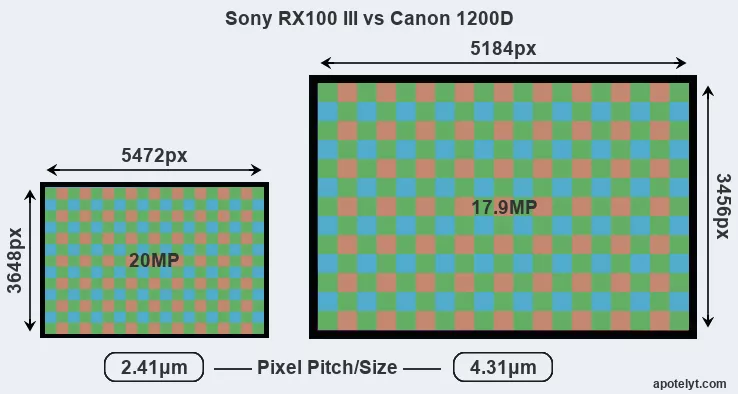
Since 2007, DXO Mark has published sensor performance measurements that have been derived using a consistent methodology. This service is based on lab testing and assigns an overall score to each camera sensor, as well as ratings for dynamic range ("DXO Landscape"), color depth ("DXO Portrait"), and low-light sensitivity ("DXO Sports"). Of the two cameras under review, the RX100 III has a notably higher overall DXO score than the 1200D (overall score 4 points higher), which gives it an advantage in terms of imaging quality. This advantage is based on 0.5 bits higher color depth, 1 EV in additional dynamic range, and 0.5 stops of reduced low light sensitivity. The adjacent table reports on the physical sensor characteristics and the outcomes of the DXO sensor quality tests for a sample of comparator-cameras.

| Camera Model |
Sensor Class |
Resolution (MP) |
Horiz. Pixels |
Vert. Pixels |
Video Format |
DXO Portrait |
DXO Landscape |
DXO Sports |
DXO Overall |
||
|---|---|---|---|---|---|---|---|---|---|---|---|
| 1. | Sony RX100 III | 1-inch | 20.0 | 5472 | 3648 | 1080/60p | 22.4 | 12.3 | 495 | 67 | |
| 2. | Canon 1200D | APS-C | 17.9 | 5184 | 3456 | 1080/30p | 21.9 | 11.3 | 724 | 63 | |
| 3. | Canon 100D | APS-C | 17.9 | 5184 | 3456 | 1080/30p | 21.8 | 11.3 | 843 | 63 | |
| 4. | Canon 700D | APS-C | 17.9 | 5184 | 3456 | 1080/30p | 21.7 | 11.2 | 681 | 61 | |
| 5. | Canon 1100D | APS-C | 12.2 | 4272 | 2848 | 720/30p | 21.9 | 11.0 | 755 | 62 | |
| 6. | Canon 1300D | APS-C | 17.9 | 5184 | 3456 | 1080/30p | 22.0 | 11.7 | 781 | 66 | |
| 7. | Canon 4000D | APS-C | 17.9 | 5184 | 3456 | 1080/30p | 21.9 | 11.4 | 695 | 63 | |
| 8. | Canon G5 X | 1-inch | 20.0 | 5472 | 3648 | 1080/60p | 21.4 | 12.3 | 471 | 62 | |
| 9. | Canon G7 X | 1-inch | 20.0 | 5472 | 3648 | 1080/60p | 23.0 | 12.7 | 556 | 71 | |
| 10. | Panasonic FZ1000 | 1-inch | 20.0 | 5472 | 3648 | 4K/30p | 22.1 | 11.7 | 517 | 64 | |
| 11. | Sony RX100 | 1-inch | 20.0 | 5472 | 3648 | 1080/60p | 22.6 | 12.4 | 390 | 66 | |
| 12. | Sony RX100 II | 1-inch | 20.0 | 5472 | 3648 | 1080/60p | 22.5 | 12.4 | 483 | 67 | |
| 13. | Sony RX100 IV | 1-inch | 20.0 | 5472 | 3648 | 4K/30p | 22.8 | 12.6 | 591 | 70 | |
| 14. | Sony RX100 V | 1-inch | 20.0 | 5472 | 3648 | 4K/30p | 22.8 | 12.4 | 586 | 70 | |
| 15. | Sony RX100 VII | 1-inch | 20.0 | 5472 | 3648 | 4K/30p | 21.8 | 12.4 | 418 | 63 | |
| 16. | Sony ZV-1 | 1-inch | 20.0 | 5472 | 3648 | 4K/30p | 22.2 | 12.6 | 669 | 66 | |
| 17. | Sony ZV-1 II | 1-inch | 20.0 | 5472 | 3648 | 4K/30p | 22.3 | 12.9 | 965 | 67 | |
| Note: DXO values in italics represent estimates based on sensor size and age. | |||||||||||
Many modern cameras cannot only take still pictures, but also record videos. Both cameras under consideration are equipped with sensors that have a sufficiently high read-out speed for moving images, but the RX100 III provides a higher frame rate than the 1200D. It can shoot video footage at 1080/60p, while the Canon is limited to 1080/30p.
Feature comparison
Beyond body and sensor, cameras can and do differ across a range of features. For example, the RX100 III has an electronic viewfinder (1440k dots), while the 1200D has an optical one. Both systems have their advantages, with the electronic viewfinder making it possible to project supplementary shooting information into the framing view, whereas the optical viewfinder offers lag-free viewing and a very clear framing image. The viewfinder in the RX100 III offers a wider field of view (100%) than the one in the 1200D (95%), so that a larger proportion of the captured image is visible in the finder. In addition, the viewfinder of the RX100 III has a higher magnification (0.59x vs 0.50x), so that the size of the image transmitted appears closer to the size seen with the naked human eye. The adjacent table lists some of the other core features of the Sony RX100 III and Canon 1200D along with similar information for a selection of comparators.

| Camera Model |
Viewfinder (Type or 000 dots) |
Control Panel (yes/no) |
LCD Specifications (inch/000 dots) |
LCD Attach- ment |
Touch Screen (yes/no) |
Max Shutter Speed * |
Max Shutter Flaps * |
Built-in Flash (yes/no) |
Built-in Image Stab |
||
|---|---|---|---|---|---|---|---|---|---|---|---|
| 1. | Sony RX100 III | 1440 | n | 3.0 / 1229 | tilting | n | 1/2000s | 10.0/s | Y | Y | |
| 2. | Canon 1200D | optical | n | 3.0 / 460 | fixed | n | 1/4000s | 3.0/s | Y | n | |
| 3. | Canon 100D | optical | n | 3.0 / 1040 | fixed | Y | 1/4000s | 4.9/s | Y | n | |
| 4. | Canon 700D | optical | n | 3.0 / 1040 | swivel | Y | 1/4000s | 5.0/s | Y | n | |
| 5. | Canon 1100D | optical | n | 2.7 / 230 | fixed | n | 1/4000s | 3.0/s | Y | n | |
| 6. | Canon 1300D | optical | n | 3.0 / 920 | fixed | n | 1/4000s | 3.0/s | Y | n | |
| 7. | Canon 4000D | optical | n | 2.7 / 230 | fixed | n | 1/4000s | 3.0/s | Y | n | |
| 8. | Canon G5 X | 2360 | n | 3.0 / 1040 | swivel | Y | 1/2000s | 5.9/s | Y | Y | |
| 9. | Canon G7 X | none | n | 3.0 / 1040 | tilting | Y | 1/2000s | 6.5/s | Y | Y | |
| 10. | Panasonic FZ1000 | 2359 | n | 3.0 / 921 | swivel | n | 1/4000s | 12.0/s | Y | Y | |
| 11. | Sony RX100 | none | n | 3.0 / 1229 | fixed | n | 1/2000s | 10.0/s | Y | Y | |
| 12. | Sony RX100 II | optional | n | 3.0 / 1229 | tilting | n | 1/2000s | 10.0/s | Y | Y | |
| 13. | Sony RX100 IV | 2359 | n | 3.0 / 1228 | tilting | n | 1/2000s | 16.0/s | Y | Y | |
| 14. | Sony RX100 V | 2359 | n | 3.0 / 1229 | tilting | n | 1/2000s | 24.0/s | Y | Y | |
| 15. | Sony RX100 VII | 2359 | n | 3.0 / 921 | tilting | Y | 1/2000s | 90.0/s | Y | Y | |
| 16. | Sony ZV-1 | none | n | 3.0 / 922 | swivel | Y | 1/2000s | 24.0/s | n | n | |
| 17. | Sony ZV-1 II | none | n | 3.0 / 922 | swivel | Y | 1/2000s | 24.0/s | n | n | |
| Note: *) Information refers to the mechanical shutter, unless the camera only has an electronic one. | |||||||||||
The RX100 III writes its imaging data to SDXC or Memory Stick PRO Duo cards, while the 1200D uses SDXC cards. The RX100 III supports UHS-I cards (Ultra High Speed data transfer of up to 104 MB/s), while the 1200D cannot take advantage of Ultra High Speed SD cards.
Connectivity comparison
For some imaging applications, the extent to which a camera can communicate with its environment can be an important aspect in the camera decision process. The table below provides an overview of the connectivity of the Sony Cyber-shot DSC-RX100 III and Canon EOS 1200D and, in particular, the interfaces the cameras (and selected comparators) provide for accessory control and data transfer.

| Camera Model |
Hotshoe Port |
Internal Mic / Speaker |
Microphone Port |
Headphone Port |
HDMI Port |
USB Port |
WiFi Support |
NFC Support |
Bluetooth Support |
||
|---|---|---|---|---|---|---|---|---|---|---|---|
| 1. | Sony RX100 III | - | stereo / mono | - | - | micro | 2.0 | Y | Y | - | |
| 2. | Canon 1200D | Y | mono / mono | - | - | mini | 2.0 | - | - | - | |
| 3. | Canon 100D | Y | mono / mono | Y | - | mini | 2.0 | - | - | - | |
| 4. | Canon 700D | Y | stereo / mono | Y | - | mini | 2.0 | - | - | - | |
| 5. | Canon 1100D | Y | stereo / mono | - | - | mini | 2.0 | - | - | - | |
| 6. | Canon 1300D | Y | mono / mono | - | - | mini | 2.0 | Y | Y | - | |
| 7. | Canon 4000D | Y | mono / mono | - | - | mini | 2.0 | Y | Y | - | |
| 8. | Canon G5 X | Y | stereo / mono | - | - | mini | 2.0 | Y | Y | - | |
| 9. | Canon G7 X | - | stereo / mono | - | - | micro | 2.0 | Y | Y | - | |
| 10. | Panasonic FZ1000 | Y | stereo / mono | Y | - | micro | 2.0 | Y | Y | - | |
| 11. | Sony RX100 | - | stereo / mono | - | - | micro | 2.0 | - | - | - | |
| 12. | Sony RX100 II | Y | stereo / mono | - | - | micro | 2.0 | Y | Y | - | |
| 13. | Sony RX100 IV | - | stereo / mono | - | - | micro | 2.0 | Y | Y | - | |
| 14. | Sony RX100 V | - | stereo / mono | - | - | micro | 2.0 | Y | Y | - | |
| 15. | Sony RX100 VII | - | stereo / mono | Y | - | micro | 2.0 | Y | Y | Y | |
| 16. | Sony ZV-1 | Y | stereo / mono | Y | - | micro | 2.0 | Y | - | Y | |
| 17. | Sony ZV-1 II | Y | stereo / mono | Y | - | micro | 2.0 | Y | - | Y |
It is notable that the RX100 III offers wifi support, while the 1200D does not. Wifi can be a very convenient means to transfer image data to an off-camera location.
Both the RX100 III and the 1200D have been discontinued, but can regularly be found used on ebay. The 1200D was replaced by the Canon 1300D, while the RX100 III was followed by the Sony RX100 IV. Further information on the features and operation of the RX100 III and 1200D can be found, respectively, in the Sony RX100 III Manual (free pdf) or the online Canon 1200D Manual.
Review summary
So what conclusions can be drawn? Is the Sony RX100 III better than the Canon 1200D or vice versa? The listing below highlights the relative strengths of the two models.

Arguments in favor of the Sony Cyber-shot DSC-RX100 III:
- More detail: Offers more megapixels (20 vs 17.9MP) with a 6% higher linear resolution.
- Better image quality: Scores markedly higher (4 points) in the DXO overall assessment.
- More dynamic range: Captures a larger spectrum of light and dark details (1 EV of extra DR).
- Better video: Provides higher movie framerates (1080/60p versus 1080/30p).
- More framing info: Has an electronic viewfinder that displays shooting data.
- More complete view: Has a viewfinder with a larger field of view (100% vs 95%).
- Larger viewfinder image: Features a viewfinder with a higher magnification (0.59x vs 0.50x).
- More detailed LCD: Has a higher resolution rear screen (1229k vs 460k dots).
- More flexible LCD: Has a tilting screen for odd-angle shots in landscape orientation.
- More selfie-friendly: Has an articulated screen that can be turned to be front-facing.
- Faster burst: Shoots at higher frequency (10 vs 3 flaps/sec) to capture the decisive moment.
- Ready to shoot: Comes with a built-in lens, while the 1200D requires a separate lens.
- More compact: Is smaller (102x58mm vs 130x100mm) and thus needs less room in the bag.
- Less heavy: Is lighter even though it comes with a built-in lens (unlike the 1200D).
- Easier travel charging: Can be conveniently charged via its USB port.
- Sharper images: Has hand-shake reducing image stabilization built-in.
- Easier file upload: Has wifi built in for automatic backup or image transfer to the web.
- Easier device pairing: Supports NFC for fast wireless image transfer over short distances.
- Faster buffer clearing: Has an SD card interface that supports the UHS-I standard.
- More modern: Is somewhat more recent (announced 3 months after the 1200D).

Advantages of the Canon EOS 1200D:
- Better low-light sensitivity: Can shoot in dim conditions (0.5 stops ISO advantage).
- Brighter framing: Features an optical viewfinder for clear, lag-free composition.
- Faster shutter: Has higher mechanical shutter speed (1/4000s vs 1/2000s) to freeze action.
- More flexible: Makes it possible to change lenses and thus to use specialty optics.
- Longer lasting: Gets more shots (500 versus 320) out of a single battery charge.
- Better lighting: Features a hotshoe and can thus hold and trigger an external flash gun.
- More heavily discounted: Has been on the market for longer (launched in February 2014).
If the count of relative strengths (bullet points above) is taken as a measure, the RX100 III is the clear winner of the match-up (20 : 7 points). However, the pertinence of the various camera strengths will differ across photographers, so that you might want to weigh individual camera traits according to their importance for your own imaging needs before making a camera decision. A professional wildlife photographer will view the differences between cameras in a way that diverges from the perspective of a family photog, and a person interested in architecture has distinct needs from a sports shooter. Hence, the decision which camera is best and worth buying is often a very personal one.
How about other alternatives? Do the specifications of the Sony RX100 III and the Canon 1200D place the cameras among the top in their class? Find out in the latest Best Travel-Zoom Camera and Best DSLR Camera listings whether the two cameras rank among the cream of the crop.
In any case, while the specs-based evaluation of cameras can be instructive in revealing their potential as photographic tools, it remains partial and cannot reveal, for example, the shooting experience and imaging performance when actually working with the RX100 III or the 1200D. User reviews that are available, for instance, at amazon can sometimes shed light on these issues, but such feedback is all too often partial, inconsistent, and inaccurate.
Expert reviews
This is why expert reviews are important. The following table reports the overall ratings of the cameras as published by some of the major camera review sites (amateurphotographer [AP], cameralabs [CL], digitalcameraworld [DCW], dpreview [DPR], ephotozine [EPZ], photographyblog [PB]). As can be seen, the professional reviewers agree in many cases on the quality of different cameras, but sometimes their assessments diverge, reinforcing the earlier point that a camera decision is often a very personal choice.

| Camera Model |
AP score |
CL score |
DCW score |
DPR score |
EPZ score |
PB score |
Camera Launch |
Launch Price (USD) |
Street Price |
||
|---|---|---|---|---|---|---|---|---|---|---|---|
| 1. | Sony RX100 III | 5/5 | + + | .. | 82/100 | 4.5/5 | 5/5 | May 2014 | 799 | ebay.com | |
| 2. | Canon 1200D | 3/5 | + | .. | .. | 4/5 | 4.5/5 | Feb 2014 | 449 | ebay.com | |
| 3. | Canon 100D | 4/5 | + | .. | 78/100 | 4/5 | 4/5 | Mar 2013 | 549 | ebay.com | |
| 4. | Canon 700D | .. | .. | .. | 76/100 | 4.5/5 | 4.5/5 | Mar 2013 | 649 | ebay.com | |
| 5. | Canon 1100D | .. | 80/100 | .. | 69/100 | 4/5 | 4.5/5 | Feb 2011 | 449 | ebay.com | |
| 6. | Canon 1300D | 4/5 | o | 4/5 | 73/100 | 4/5 | 4/5 | Mar 2016 | 449 | ebay.com | |
| 7. | Canon 4000D | 2.5/5 | o | 3/5 | .. | 3.5/5 | 3.5/5 | Feb 2018 | 399 | amazon.com | |
| 8. | Canon G5 X | 5/5 | + + | .. | 78/100 | 4.5/5 | 4.5/5 | Oct 2015 | 799 | ebay.com | |
| 9. | Canon G7 X | 4/5 | + + | .. | 77/100 | 4.5/5 | 4.5/5 | Sep 2014 | 699 | ebay.com | |
| 10. | Panasonic FZ1000 | 4/5 | + + | .. | 82/100 | 4.5/5 | 4.5/5 | Jun 2014 | 899 | ebay.com | |
| 11. | Sony RX100 | 5/5 | + + | .. | 78/100 | 4/5 | 5/5 | Jun 2012 | 649 | ebay.com | |
| 12. | Sony RX100 II | 5/5 | + + | .. | 79/100 | 4.5/5 | 4.5/5 | Jun 2013 | 749 | ebay.com | |
| 13. | Sony RX100 IV | 4.5/5 | + + | .. | 85/100 | 4/5 | 4.5/5 | Jun 2015 | 999 | ebay.com | |
| 14. | Sony RX100 V | 4.5/5 | + + | .. | 83/100 | 4/5 | 4.5/5 | Oct 2016 | 999 | ebay.com | |
| 15. | Sony RX100 VII | 4.5/5 | .. | 4/5 | .. | 4/5 | 5/5 | Jul 2019 | 1,199 | amazon.com | |
| 16. | Sony ZV-1 | 4/5 | + | 4/5 | 85/100 | 4/5 | 4.5/5 | May 2020 | 799 | ebay.com | |
| 17. | Sony ZV-1 II | 4.5/5 | .. | 3.5/5 | 83/100 | 3.5/5 | 4.5/5 | May 2023 | 899 | amazon.com | |
| Note: (+ +) highly recommended; (+) recommended; (o) reviewed; (..) not available. | |||||||||||
Care should be taken when interpreting the review scores above, though. The ratings were established in reference to similarly priced cameras that were available in the market at the time of the review. Hence, a score should always be seen in the context of the camera's market launch date and its price, and comparisons of ratings among very different cameras or across long time periods have little meaning. Also, please note that some of the review sites have changed their methodology and reporting over time.

Check RX100 III offers at
ebay.com

Check 1200D offers at
ebay.com
Other camera comparisons
Did this review help to inform your camera decision process? In case you are interested in seeing how other cameras pair up, just make a corresponding selection in the search boxes below. There is also a set of direct links to comparison reviews that other users of the CAM-parator app explored.
- Canon 1200D vs Canon 1D X
- Canon 1200D vs Canon 7D II
- Canon 1200D vs Leica D-LUX 5
- Canon 1200D vs Olympus E-PM2
- Canon 1200D vs Panasonic G6
- Canon 1200D vs Sony A99
- Canon 1D Mark IV vs Sony RX100 III
- Canon M3 vs Sony RX100 III
- Fujifilm X-S20 vs Sony RX100 III
- Leica S Typ 006 vs Sony RX100 III
- Nikon 1 J5 vs Sony RX100 III
- Panasonic GH3 vs Sony RX100 III
Specifications: Sony RX100 III vs Canon 1200D
Below is a side-by-side comparison of the specs of the two cameras to facilitate a quick review of their differences and common features.
| Camera Model | Sony RX100 III | Canon 1200D |
|---|---|---|
| Camera Type | Fixed lens compact camera | Digital single lens reflex |
| Camera Lens | 24-70mm f/1.8-2.8 | Canon EF mount lenses |
| Launch Date | May 2014 | February 2014 |
| Launch Price | USD 799 | USD 449 |
| Sensor Specs | Sony RX100 III | Canon 1200D |
| Sensor Technology | BSI-CMOS | CMOS |
| Sensor Format | 1" Sensor | APS-C Sensor |
| Sensor Size | 13.2 x 8.8 mm | 22.3 x 14.9 mm |
| Sensor Area | 116.16 mm2 | 332.27 mm2 |
| Sensor Diagonal | 15.9 mm | 26.8 mm |
| Crop Factor | 2.7x | 1.6x |
| Sensor Resolution | 20 Megapixels | 17.9 Megapixels |
| Image Resolution | 5472 x 3648 pixels | 5184 x 3456 pixels |
| Pixel Pitch | 2.41 μm | 4.31 μm |
| Pixel Density | 17.18 MP/cm2 | 5.39 MP/cm2 |
| Moiré control | Anti-Alias filter | Anti-Alias filter |
| Movie Capability | 1080/60p Video | 1080/30p Video |
| ISO Setting | 100 - 12,800 ISO | 100 - 6,400 ISO |
| ISO Boost | 80 - 25,600 ISO | 100 - 12,800 ISO |
| Image Processor | BIONZ X | DIGIC 4 |
| DXO Sensor Quality (score) | 67 | 63 |
| DXO Color Depth (bits) | 22.4 | 21.9 |
| DXO Dynamic Range (EV) | 12.3 | 11.3 |
| DXO Low Light (ISO) | 495 | 724 |
| Screen Specs | Sony RX100 III | Canon 1200D |
| Viewfinder Type | Electronic viewfinder | Optical viewfinder |
| Viewfinder Field of View | 100% | 95% |
| Viewfinder Magnification | 0.59x | 0.50x |
| Viewfinder Resolution | 1440k dots | |
| LCD Framing | Live View | Live View |
| Rear LCD Size | 3.0inch | 3.0inch |
| LCD Resolution | 1229k dots | 460k dots |
| LCD Attachment | Tilting screen | Fixed screen |
| Shooting Specs | Sony RX100 III | Canon 1200D |
| Focus System | Contrast-detect AF | Phase-detect AF |
| Manual Focusing Aid | Focus Peaking | no Peaking Feature |
| Continuous Shooting | 10 shutter flaps/s | 3 shutter flaps/s |
| Fill Flash | Built-in Flash | Built-in Flash |
| Storage Medium | MS or SDXC cards | SDXC cards |
| Single or Dual Card Slots | Single card slot | Single card slot |
| UHS card support | UHS-I | no |
| Connectivity Specs | Sony RX100 III | Canon 1200D |
| External Flash | no Hotshoe | Hotshoe |
| USB Connector | USB 2.0 | USB 2.0 |
| HDMI Port | micro HDMI | mini HDMI |
| Wifi Support | Wifi built-in | no Wifi |
| Near-Field Communication | NFC built-in | no NFC |
| Body Specs | Sony RX100 III | Canon 1200D |
| Battery Type | Sony NP-BX1 | Canon LP-E10 |
| Battery Life (CIPA) | 320 shots per charge | 500 shots per charge |
| In-Camera Charging | USB charging | no USB charging |
| Body Dimensions |
102 x 58 x 41 mm (4.0 x 2.3 x 1.6 in) |
130 x 100 x 78 mm (5.1 x 3.9 x 3.1 in) |
| Camera Weight | 290 g (10.2 oz) | 480 g (16.9 oz) |

Check RX100 III offers at
ebay.com

Check 1200D offers at
ebay.com
Did you notice an error on this page? If so, please get in touch, so that we can correct the information.

